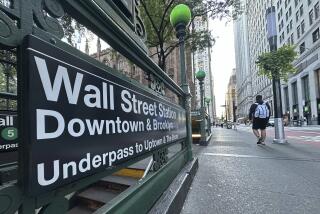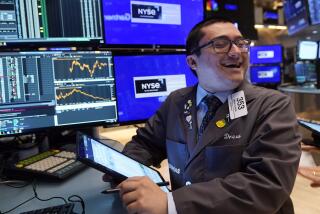Asia Turmoil May Signal Bigger Woes
- Share via
Asia’s financial woes, which a few weeks ago were expected to result in just a mild “flu” for the rest of the global economy, now are raising concerns about something more serious ahead.
The potential for worldwide recession, and a full-blown Japanese banking crisis, have become far more widely discussed in financial circles in recent days. Even if such calamities don’t materialize, many analysts are now conceding that U.S. economic growth could be hurt more than originally anticipated by Asia’s troubles.
Wall Street’s change in tone from the generally sanguine commentary of late October reflects a number of warning signs that have appeared in recent weeks, following global stock markets’ mini-crashes of Oct. 27 and 28.
For one, after an initial sharp rebound from the late October plunge, world stock prices in general have slumped again in recent days, which analysts say may foreshadow more economic turmoil on the horizon.
In addition, the Brazilian government’s decision Monday to adopt an economic austerity plan to pare government spending--a plan aimed at staving off an Asia-style currency devaluation--confirmed that Latin America had been infected by Asia’s illness.
Perhaps most significant, Japan’s stock market has tumbled to two-year lows, and beleaguered Japanese banks have been forced to pay higher interest rates to borrow from other world banks in recent days--a sign of increasing concern about the stability of Japan’s financial system.
Federal Reserve Board Chairman Alan Greenspan did little to assuage investors’ concerns on Thursday, when he testified before the House Banking Committee about the potential fallout from Asia’s turmoil on the U.S. economy.
Greenspan would not quantify the possible effects of the crisis on the United States, but in the tortured English he often uses on Capitol Hill, he said the impact “can be expected not to be negligible.”
“It is in everybody’s interest, and especially the interests of the United States, that this weakness in the Asian economic and financial system be reversed as quickly as feasible,” the Fed chief added.
Analysts said Greenspan’s testimony was meant to be measured and non-alarmist, because the last thing financial markets would want to hear is an expression of deep concern on the part of the Federal Reserve.
But in Japan early today, Eisuke Sakakibara, the country’s top finance official, used blunter language. With the currency and market devaluations that have swept Asia, Sakakibara said the world faces a greater risk of deflation, meaning a ruinous cycle of falling prices for goods, services and assets.
“It’s most important to restore the credibility of the financial system in a clear-cut way in order to prevent such a crash,” he said.
To be sure, most Wall Street advisors still don’t believe that Asia’s problems, which began with widespread currency devaluations in July and have since triggered stock market plunges and soaring interest rates across the region, will result in global calamity.
In fact, many experts still predict only a modest slowdown in the U.S. economy in the first half of 1998, as export growth stagnates because Asian nations whose currencies have been sharply devalued won’t be able to afford as many U.S. goods. Asia, as a whole, buys about one-third of U.S. merchandise exports.
Gail Fosler, economist at the Conference Board in New York, projects that U.S. real economic growth will decline to 3% in 1998 from what she believes would have been a 3.25% rate had Asia not stumbled into trouble.
*
Others have turned more cautious. “The currency turmoil in Asia is playing out worse than we expected,” brokerage Bear, Stearns & Co. economists Wayne Angell and John Ryding told clients in a memo Wednesday. With recession expected to spread across Southeast Asia in 1998, Angell and Ryding now believe that Japan “may not grow at all next year.”
That, in turn, could drag U.S. economic growth down to a 2.25% annualized rate in the first half of next year, they estimated.
“American exports to Asia will be drying up,” predicted Gordon Richards, economist at the National Assn. of Manufacturers in Washington.
And now, with Brazil’s adoption of an austerity plan, export growth to Latin America also is in jeopardy, Richards said.
Analysts who doubt that the ultimate effect on the U.S. economy will be significant point out that America is largely dependent on itself: Internal production and consumption of goods and services account for about 80% of economic activity; trade, meaning both imports and exports, accounts for the final 20%.
But other experts note that world economies and financial systems are far more intertwined than those trade figures suggest. In particular, the hundreds of billions of dollars in credits and debits among banks and other financial institutions worldwide provide electronic highways by which trouble can spread among economies.
“Banks are recyclers of money; as such, they are quick to catch and pass along problems,” noted Ray Dalio, head of financial advisory firm Bridgewater Associates in Wilton, Conn.
This week, Wall Street was riled by rumors that New York banking giant Chase Manhattan Corp. had suffered deep losses trading emerging-market country bonds, many of which plunged in value in October as investors continued to yank money from many Asian nations and other developing countries.
On Thursday, Chase confirmed that it lost $160 million before taxes in such bond trading in October, an amount that the bank said may be large enough to keep it from achieving its earnings growth targets this year.
Chase’s stock price has plunged 15% in recent weeks on concerns about its exposure to foreign-market troubles. Other U.S. bank stocks also have fallen sharply.
Greenspan, asked specifically about bank trading activities in depressed foreign securities, said losses so far “in no way threaten in any means whatever the financial status of those institutions.”
But the bigger worries about the global financial system center not on U.S. banks but on Japanese banks. “The real problem that would keep the world awake would be a cracking of the banking system in Japan,” said James Annable, chief economist at First Chicago/NBD in Chicago.
Weakened in the early 1990s by the twin crashes in Japan’s stock market and real estate market, Japan’s banking giants remain saddled with hundreds of billions of dollars in bad loans.
Now, the economic crashes across the rest of Asia are sure to add to those bad loans, as some Asian companies that had borrowed from Japanese banks find themselves unable to make payments, with their currencies devalued by 30% or more against the Japanese yen.
What’s more, Japanese exporters, which sold 40% of their total exports last year to Southeast Asia, face the prospect of much lower sales in 1998. That could further dampen economic activity in Japan, creating a new drag on the struggling banking system.
Deepening concerns about the health of Japanese banks have forced many of those institutions to pay more for money in the global borrowing market in recent weeks, as other banks add a “risk premium” of as much as 0.2 of a percentage point to the rate they charge Japanese banks to borrow.
And fears that the Japanese economy overall--still the world’s second-largest, after the United States--is headed back into recession have triggered a sell-off in the yen in recent weeks, driving its value down to nearly 126 to the dollar, a six-month low.
*
In addition, the Japanese stock market has fallen to its lowest level in more than two years.
If Japan should spiral into recession or into a full-blown banking crisis, many economists concede that they would be forced to further lower U.S. economic growth estimates.
For its part, Japan still seems uncertain about how to deal with its massive problems.
“I’m amazed that Japan talks about putting together a bailout package for Southeast Asia, when they should be putting together a bailout package for Japan,” Fosler said.
Yet many experts doubt that the worst-case scenario--a failure of a major Japanese bank--is likely to occur, simply because the Japanese government is certain to stand behind its major institutions.
“I don’t see the biggest banks falling apart in Japan,” said Henry Kaufman, economist at Henry Kaufman & Co. in New York.
At the same time, however, he said that policymakers in the United States and elsewhere are facing the reality that there is no easy way to deal with the collapse of many Southeast Asian economies, the likelihood that Latin America now will suffer a growth slowdown as well, and Japan’s ingrained financial woes.
While Greenspan suggested Thursday that the crisis needs to be brought to a quick close, exactly how to do that remains unclear.
Unlike with the Mexican peso devaluation of 1994, which brought the United States quickly to Mexico’s aid, Asia’s troubles now are so widespread--with contagion also infecting Japan and Latin America--that “this crisis has no center, and therefore no quick fix,” Annable said.
International Monetary Fund rescues are already planned for Thailand and Indonesia. But South Korea may also need help, experts warn. And that leaves little leeway for unforeseen turmoil elsewhere.
For now, the best-case scenario is that no additional shocks hit the world economy and that U.S. consumers and companies, and perhaps European consumers and companies as well, maintain a strong pace of spending and investment to offset the weakness elsewhere in the world.
And should the global economy suddenly appear in much greater danger of sliding into recession or a banking crisis, central banks outside Japan have one final, and powerful, weapon at their disposal: They could slash short-term interest rates to essentially pour money into the world financial system.
* STOCKS MIXED
Blue chips rally, but broad market remains weak amid continuing worries. D6
More to Read
Inside the business of entertainment
The Wide Shot brings you news, analysis and insights on everything from streaming wars to production — and what it all means for the future.
You may occasionally receive promotional content from the Los Angeles Times.










